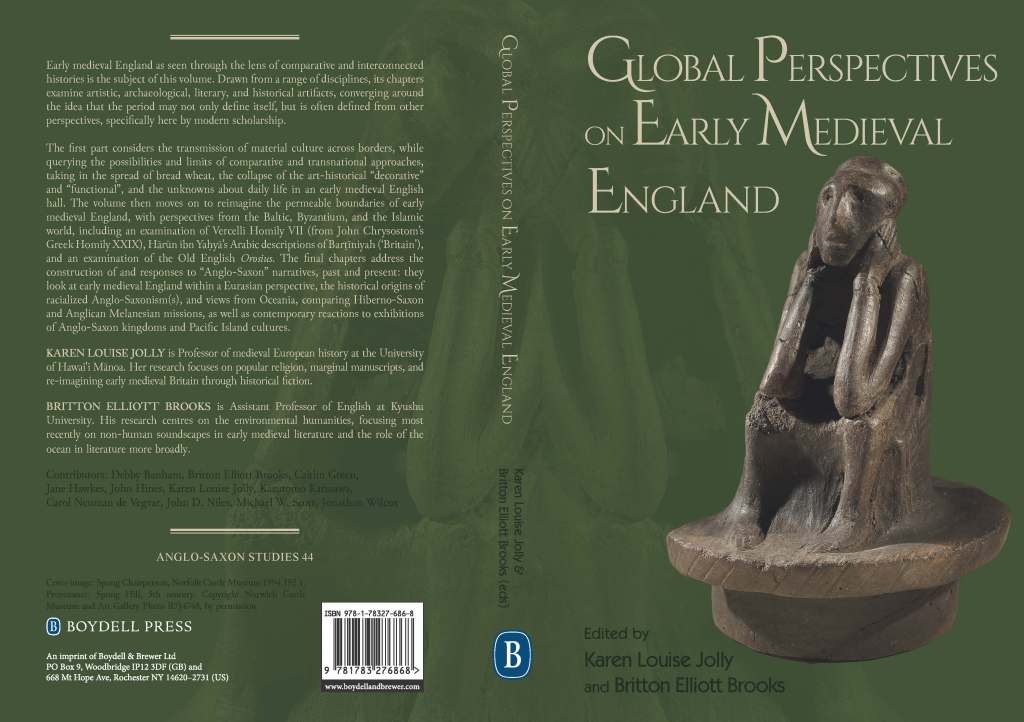Cross-post from Proofed: A Boydell & Brewer Blog, advertising the publication of the volume of essays edited by Karen Louise Jolly and Britton Elliott Brooks, Global Perspectives on Early Medieval England.
In the summer of 2007, I visited the Holy Island of Lindisfarne for the first time. I had the privilege of being driven there from Durham by the foremost archaeologist of the region, Dame Rosemary Cramp. She may not remember much of that journey—I am sure she has given innumerable tours to visiting scholars—but I have vivid memories of her regaling me with off-the-cuff but deeply insightful remarks about her changing views of the Chester-le-Street Anker house stone monuments, gesturing out the car window to Roman ruins along the road, giving insights on new discoveries at Bamburgh, and finally, showing me the artifacts of Lindisfarne, where she is the authority on much that is on display in the museum.
But I have one particular visual memory of the landscape as we drove north toward Lindisfarne. That was of the immensity of the horizon and the sky like a bowl over this huge open space of land. When I recounted this vision later to some colleagues, one pointed out, rightly so, that the landscape in that region is not flat but hilly. How can I account for my feeling of immensity?
One explanation is that my perspective is relative to where I come from. I live on an island in an archipelago at some distance from the nearest continental landmass. Britain is also an island, but a much bigger one than where I live on Oahu, a volcanic mountain sticking up from the sea. Although I was raised on the west coast of the North American continent, whenever I visit there after having lived here on this island, I am struck by how spread out everything is and how far I can see over land. I am used to gazing out over the immensity of the seascape, our sea of islands.
On Lindisfarne itself, after I arrived that first time and on subsequent visits, I had this sense of being at home on an island connected to the sea, and also a feeling of reverence for the sacredness of the past. I even blogged about having to wade back through the rising tide from St. Cuthbert’s Isle, feeling like the kind of silly tourist we complain about here in Hawai‘i.

These personal anecdotes illustrate several of the themes in the volume Global Perspectives on Early Medieval England.
One perspective is from Oceania, which seems counter-intuitive in a volume of essays reflecting on artifacts and texts from a place half way around the globe and disconnected from each other in the early medieval era. Both editors, though, are from Hawai‘i, and many of the essays originated in a 2017 conference held on Oahu exploring this idea of bringing a global perspective to bear on our field of study.
Some essays explicitly address comparisons, connections, and orientations from the Pacific in relation to early medieval England. Jane Hawkes, for example, draws on her own encounters in Oceania to query how “art” is classified in certain modern western ways, considering together both Melanesian and early medieval insular arts. Similarly, Michael W. Scott shows how 19th century Anglican missionaries to Melanesia drew on early medieval Hiberno-Saxon mission stories–and then how Melanesian Christians appropriated and developed those traditions within their own culture.
While Scott’s essay traced how early medieval Britian came to Pacific Islands, my essay in the volume talks about taking students from the Pacific to early medieval Britain. In the fall of 2018, I escorted eighteen undergraduate students from the University of Hawai‘i for a semester study abroad in London. One course I taught centered on the British Museum, exploring in particular representations of Pacific and Asian cultures familiar to my students. The other course, on early medieval Europe, focused on the stunning Anglo-Saxon Kingdoms exhibit at the British Library, with side visits to the British Museum room 41, Sutton Hoo, and Winchester.
However, the big excursion was to Northumberland, dropping down from Scotland into Lindisfarne, Jarrow, Durham, and York. At Lindisfarne, my Hawai‘i students intuitively felt the sacredness of the place, even though it was not “their island.” In part this response was due to Lindisfarne’s seclusion and relatively protected status, compared to colonized Oahu with its heavy tourism and militarism. But also these students experienced what it meant to be an early medieval pilgrim, that the journey itself made the destination meaningful. As one student of Hawaiian culture said: “the seclusion of the Holy Island made it that much more significant as a holy place, as you really had to journey to get there”. My feeling exactly.

The comparison with Oahu brings Davis Lodge’s novel “Paradise News” to mind. According to J. Russell Perkin in his critical essay “The Pilgrimages of David Lodge”, Lodge “allows a package tour to Hawaii, rather than some more esoteric kind of experience, to become a means of spiritual grace.”
By: James Rawson on April 7, 2022
at 1:19 am
Thanks, James, for the Perkin essay reference. How did I not know about this Lodge novel?
By: kljolly on April 7, 2022
at 11:20 am